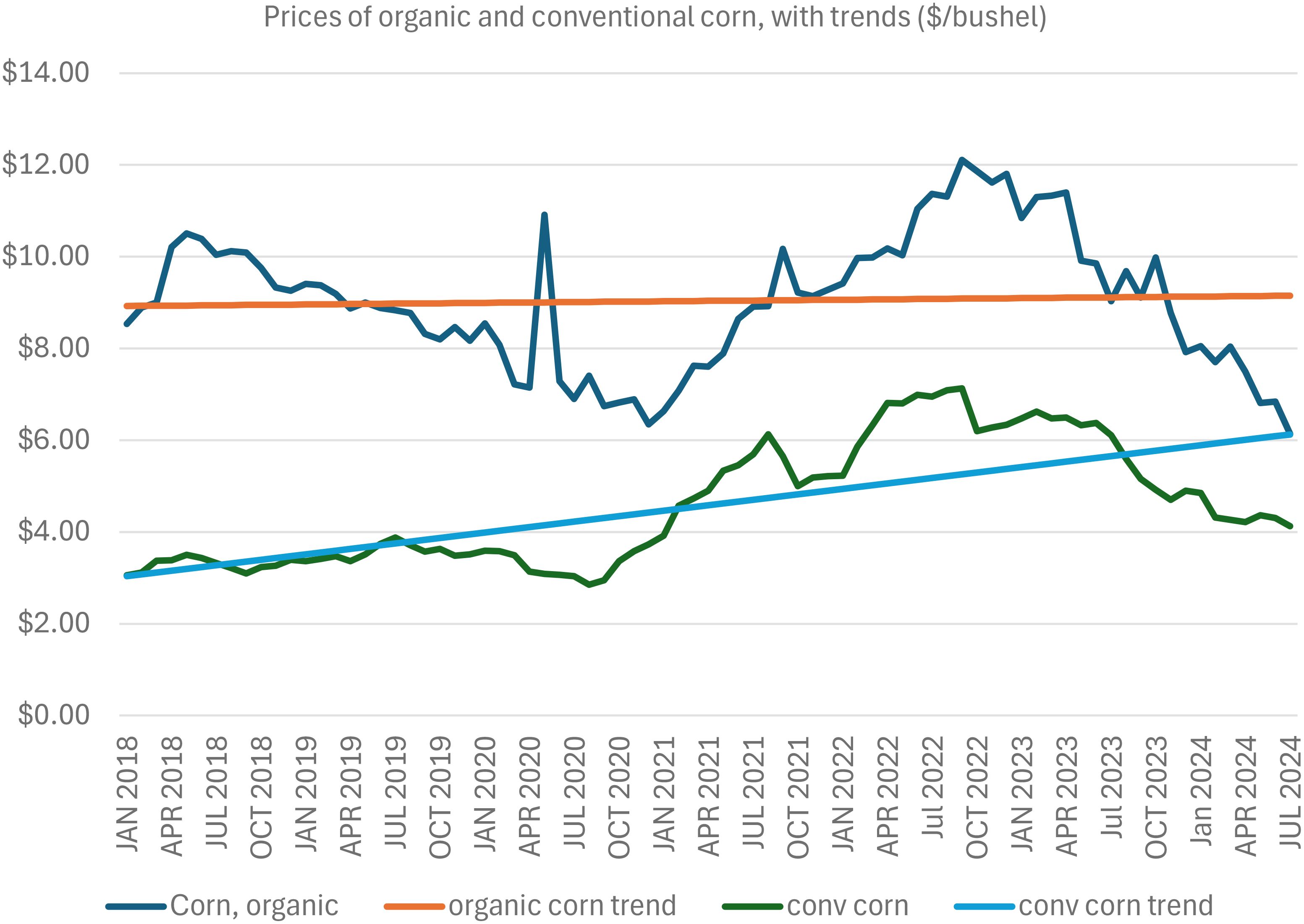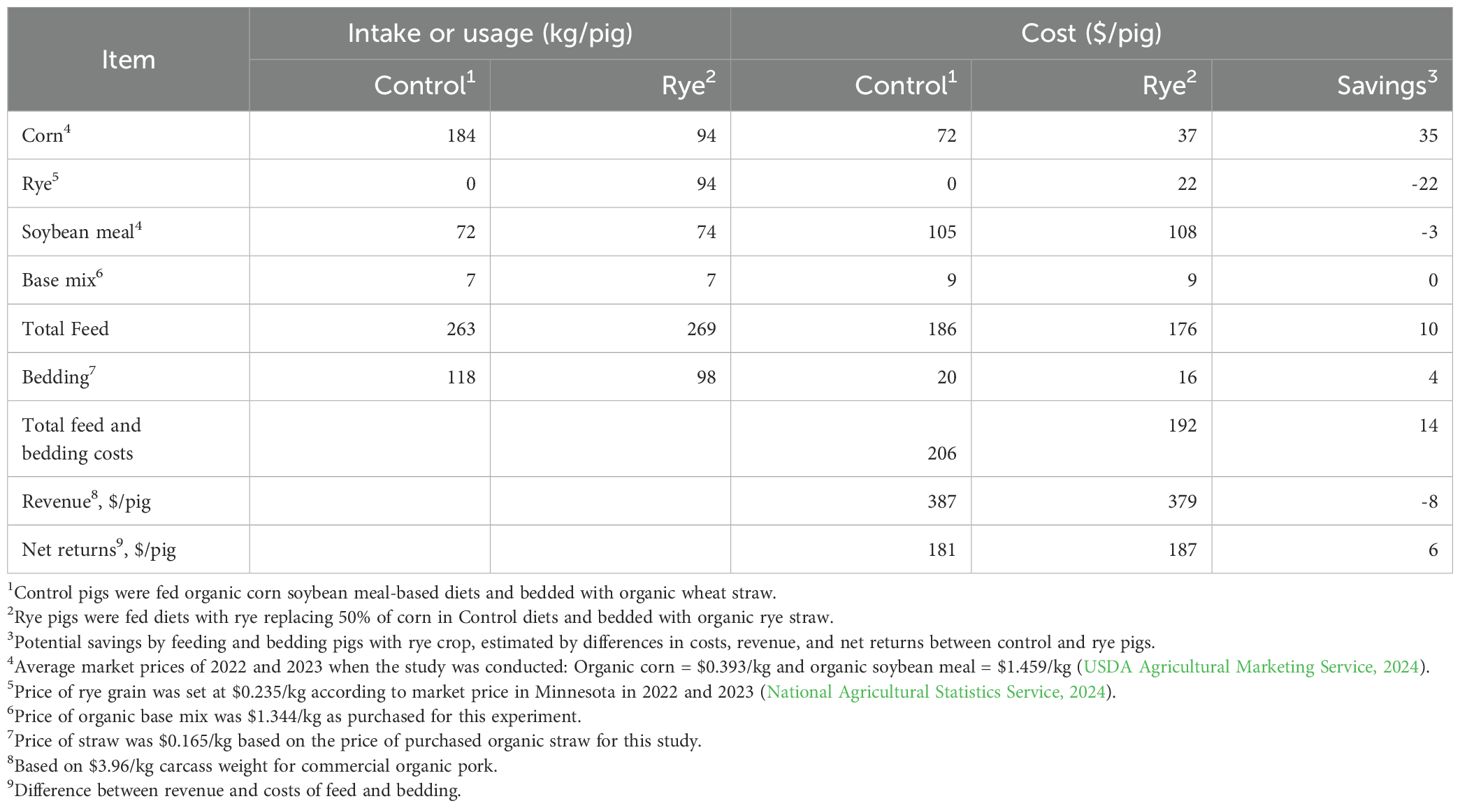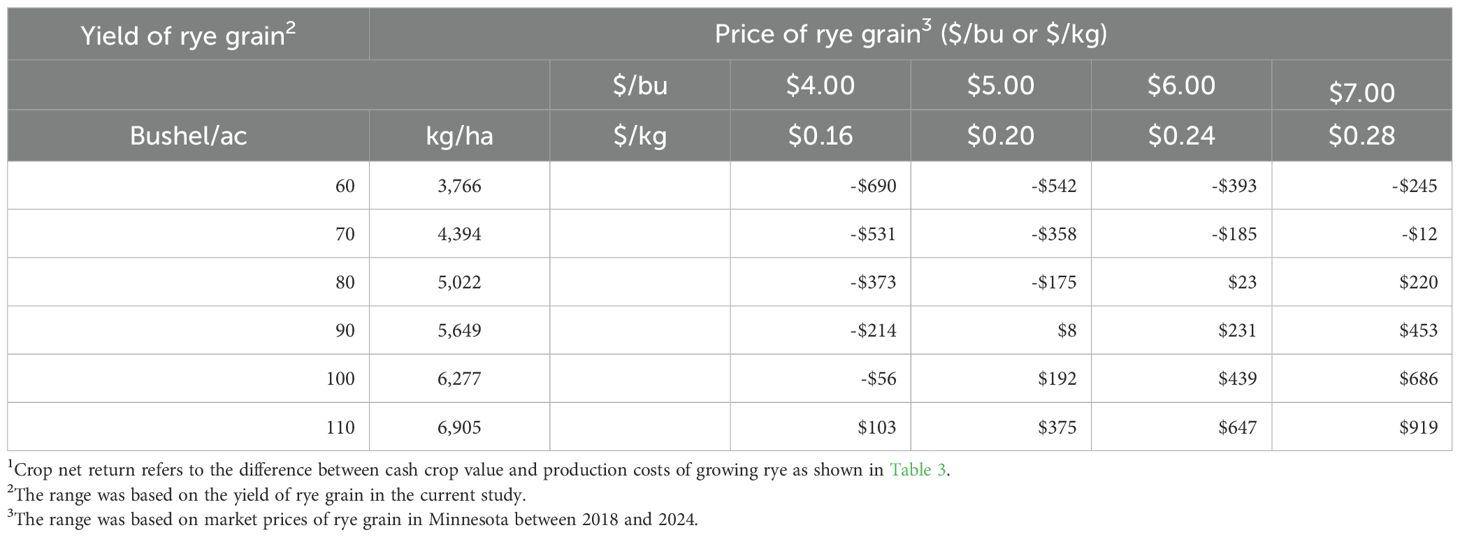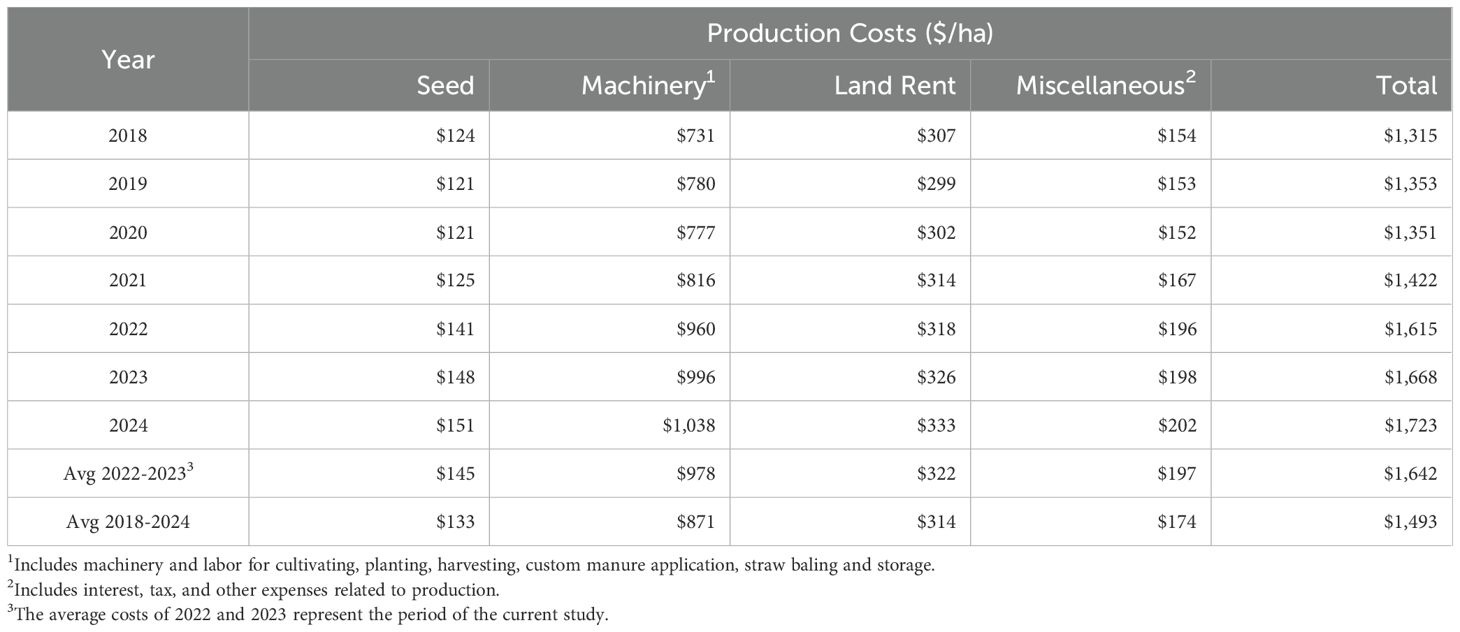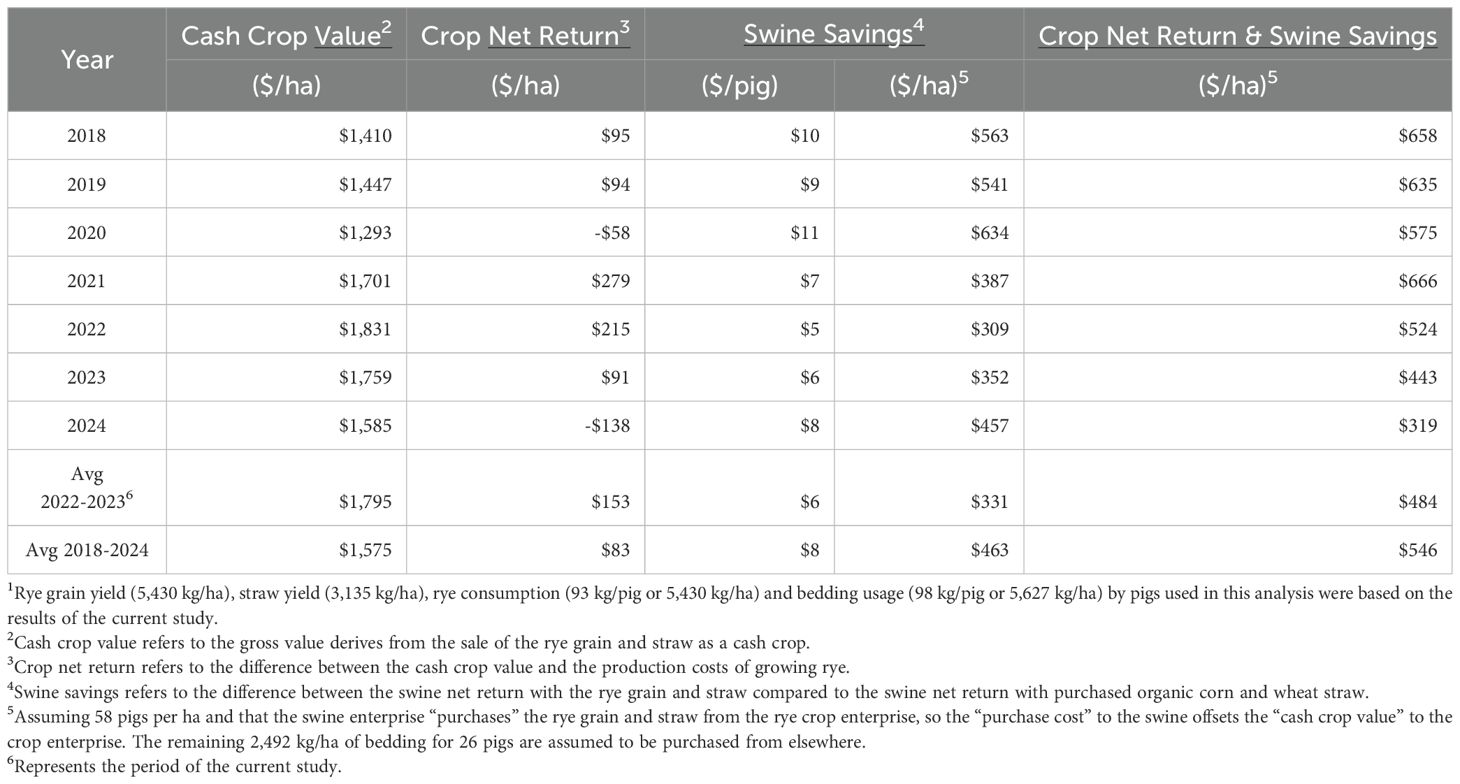- 1West Central Research and Outreach Center, University of Minnesota, Morris, MN, United States
- 2Department of Animal Science, University of Minnesota, St Paul, MN, United States
- 3Department of Applied Economics, University of Minnesota, St Paul, MN, United States
- 4Department of Soil, Water, and Climate, University of Minnesota, St Paul, MN, United States
- 5Department of Agronomy and Plant Genetics, University of Minnesota, St Paul, MN, United States
- 6Southwest Research and Outreach Center, University of Minnesota, Lamberton, MN, United States
The high production cost is one of the biggest challenges to the sustainability of organic pig production. Growing winter hybrid rye to feed and bed organic pigs might be a strategy to reduce production costs. In this study, we evaluated the economic viability of integrating rye into an organic swine production system. Winter hybrid rye was grown organically over two years, yielding an average of 5,430 kg/ha of grain and 3,135 kg/ha of straw. Replacing 50% of corn with rye grain in feed and using rye straw as bedding materials did not negatively impact growth performance of organic growing-finishing pigs. This replacement resulted in $14/pig savings on feed and bedding and increased net return for a swine enterprise (swine savings) by $6/pig, compared with feeding corn soybean meal diets and bedding with wheat straw. Sensitivity analysis was conducted to evaluate how crop net returns may vary with changes in market prices, yield, and production costs of a rye crop. Results indicate that for farmers to be profitable by growing rye as a cash crop, the minimal price of rye grain needs to be $0.24/kg at a yield of around 5,000 kg/ha with production costs of $1,642/ha. Growing rye to feed and bed organic pigs can offset crop net returns, resulting in $319 to $666/ha of crop net returns and swine savings for the combined crop and swine enterprise. These results suggest that integrating hybrid rye into organic swine production is economically viable under the circumstances described in this study and can benefit both crop and pig farmers.
1 Introduction
A major challenge in organic swine production is the high cost of feed ingredients and bedding materials. Organic feed and bedding are more expensive than their conventional counterparts due to the higher production costs and lower yields of typical organic farming systems (Schahczenski and Post, 2019; Gamage et al., 2023). For instance, prices of organic corn, the major ingredient in feed for organic pigs, were two to three times higher than those of conventional corn between 2018 and 2024 (Figure 1; Greene, 2018). Most organic pig farmers use straw from organic small grains for bedding (Lammers et al., 2007) and certified organic small grain straw also costs two to three times more than conventional straw (USDA National Agricultural Statistics Service, 2024). These elevated costs contribute to the overall increased expense of producing organic pork compared to conventional pork (Belasco and Schahczenski, 2021). Higher production costs can lead to higher prices for pork products compared with conventionally produced pork, a crucial consideration for consumers purchasing organic pork (Gross et al., 2021; Pugliese et al., 2023). Reducing these costs is essential for making organic pork and pork products economically viable for both farmers and consumers. Economic viability is critical to the sustainability of organic swine production.
Organic pig farmers may choose to grow their own organic crops to feed and bed their pigs if production costs are lower than the cost of purchasing organic feed ingredients and bedding materials. The high prices of organic feed and bedding combined with a desire to improve soil health compels organic pig producers to seek alternative ingredients and bedding materials that they can grow on their farms. Organic pig farmers have shown increased interest in winter hybrid rye due to its high yield, hardy overwintering, and environmental benefits (Basche et al., 2016; Christy, 2018; Bower, 2020). As a cover crop during non-growing seasons, winter hybrid rye can effectively decrease soil erosion and nitrogen leaching due to its fibrous root system (Hackauf et al., 2022; Herbstritt et al., 2022). Rye is a dual-purpose crop for organic pig farmers because the grain can be used as a feed ingredient in swine diets (Boggess et al., 2018; McGhee et al., 2021; Sullivan, 2023) and the straw can be used as bedding materials.
Farmers need to determine the economic viability of growing a new crop so they can properly assess the value of growing that crop on their farms. Economic viability of crop production depends on the balance between production costs and revenue generated by the crop. Organic farmers choosing to grow their own crops to feed and bed their pigs must also consider costs and revenues for swine production. For organic pig farmers, the major production costs come from expenses on feed and bedding materials. Revenue for farmers growing rye to feed and bed organic pigs depends on market prices of organic crops and pigs, crop yield, and growth performance of pigs (Li et al., 2021; Pork Checkoff, 2021). Determining the economic viability of growing rye to feed and bed pigs involves managing all these factors effectively to exceed break-even points.
The decision to incorporate an alternative feed ingredient into organic pig production is often driven by the economic viability of producing that crop and the impact of the crop as a feed ingredient on performance of pigs. Although hybrid rye has slightly lower energy content than corn for pigs (Sullivan, 2005; McGhee, 2019), its high yield of both grain and straw may make it a viable option for feed and bedding materials in organic swine production. Currently, there is no economic analysis of growing rye for organic pigs. This study aims to fill that gap, with the objective of evaluating the economic viability of integrating winter hybrid rye into organic swine production. We hypothesized that integrating hybrid rye into organic swine production would be economically viable.
2 Materials and methods
We tested the hypothesis by examining rye crop yield, growth performance of pigs, and net returns generated by growing rye and raising organic pigs when rye was used for feed and bedding. The evaluation of economic viability also included a sensitivity analysis of net returns to crop price, yield, and production costs of growing rye as a cash crop, as well as the estimated variations in net returns as production costs and market prices change. Eventually, the economic viability of growing rye as a cash crop and as feed and bedding for organic pigs were evaluated. This study was conducted at the University of Minnesota’s West Central Research and Outreach Center (WCROC) in Morris, Minnesota from 2022 through 2024.
2.1 Organic hybrid rye production
Winter hybrid rye (Tayo variety, KWS Cereals, USA) was grown and harvested over two years (Figure 2) on approximately seven hectares of certified organic land. The crop was produced according to National Organic Program standards (USDA, 2020). No herbicides, pesticides, or synthetic fertilizers were used. Liquid swine manure was injected in the soil (71 m3/ha) before planting. The targeted nutrients per hectare added with manure were 182 kg of available nitrogen, 63 kg of phosphorus, and 222 kg of potassium based on tests of the liquid manure and the application rate. The field was cultivated the day before planting. Each year, hybrid rye was planted in September at a rate of 2 million live seeds per hectare at a depth of 2.54 cm. Rye crop was harvested in early July of the following year after reaching maturity when the moisture content in the grain reached 14%. Rye grain and straw were used as an ingredient and bedding, respectively, in the pig feeding experiment described below.
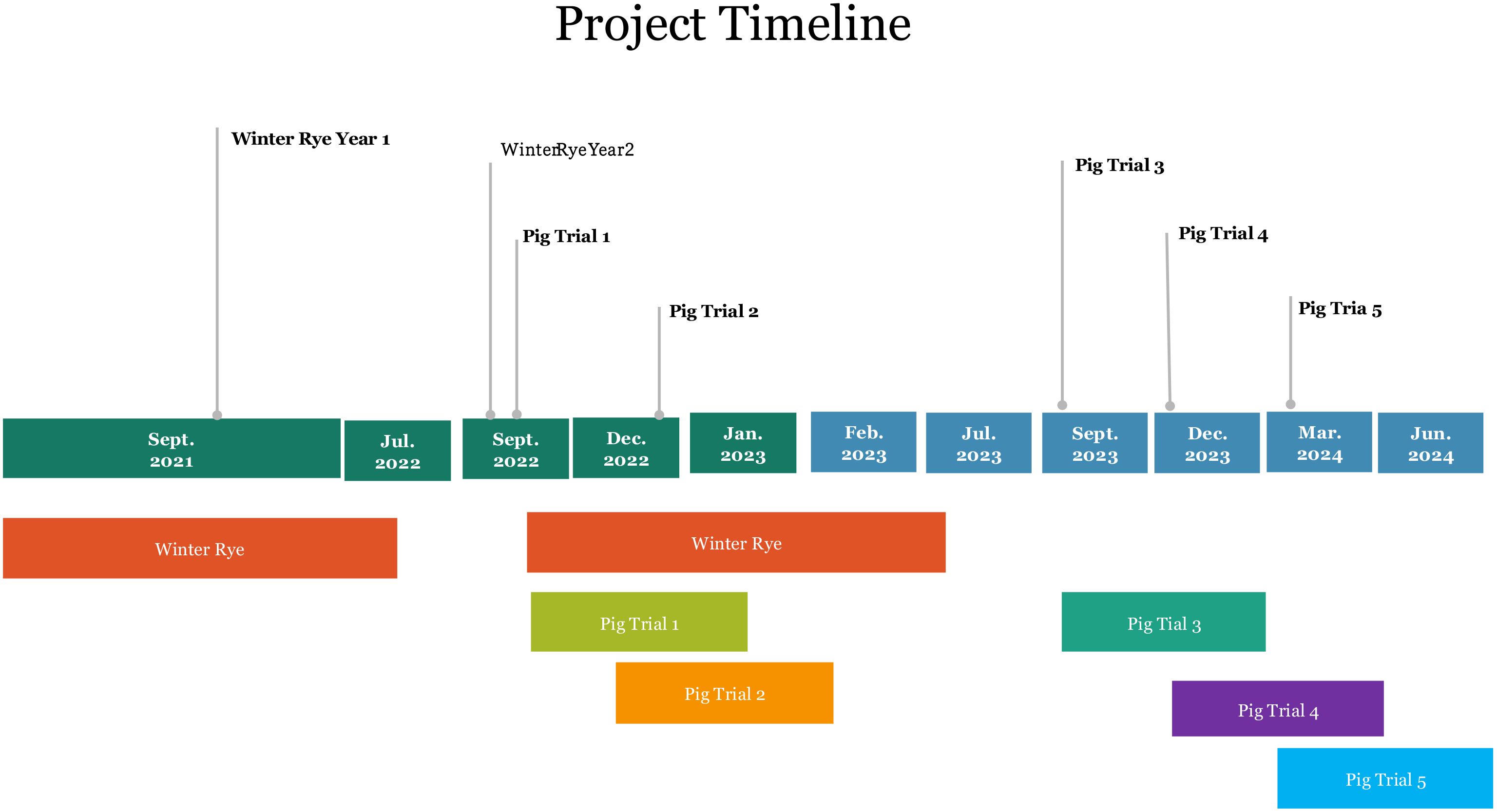
Figure 2. Timeline of the study. The box represents the duration of crop production or the pig trial. The whisker indicates the start of crop production or the pig trial.
2.2 Organic swine production
2.2.1 Animals, housing, and management
All pigs (Landrace × Z-line hybrid sows mated to Tempo sires, Topigs Norsvin, Burnsville, MN. USA, n = 500) used in this study were born at the WCROC and managed according to standards established by the National Organic Program (NOP (National Organic Program), 2013; USDA, 2020) for certified organic swine production. Piglets were weaned at 6 weeks of age as required for organic production. At 8 weeks of age, pigs were transferred to growing-finishing hoop barns where they remained until market weight. Each hoop barn was divided into two pens and each pen measured 6 m × 24 m. Fifty pigs were housed in each pen and allowed ad libitum access to feed in a feeder with 12 feeding spaces and water in an automated water fountain with 4 drinking spaces. All diets fed to pigs were formulated to meet or exceed nutritional requirements for pigs according to recommendations of the National Research Council (NRC (National Research Council), 2012). Pigs were provided with straw as bedding materials.
2.2.2 Experimental design of the feeding experiment
A randomized complete block design was used. Each hoop barn was considered a block. Within each block, two dietary treatments were tested with pigs in two pens (50 pigs/pen). The control diet consisted of corn, soybean meal (SBM), and a base mix that supplied minerals and vitamins. In the treatment diet, 50% of the corn from the control diet was replaced with rye produced in this study. The feeding experiment was conducted during the growing-finishing period (8 weeks of age to market weight). Five phases of diet were fed to pigs during the study period. The formula and composition of each diet are reported in a companion paper (Lima et al., 2025). Straw bales (4 to 7 bales at about 350 kg/bale) were spread on the floor in each pen before pigs entered the barn. Additional straw bales were provided as the pigs grew so all pigs in each pen had constant access to dry bedding throughout the growing-finishing period.
Pigs (Landrace × Z-line hybrid sows mated to Tempo line sires, Topigs Norsvin, Burnsville, MN. USA) were allotted randomly to the Rye or Control pen within a hoop barn at 8 weeks of age with weight and sex being balanced across pens. Pigs were allowed a two-week adaptation period in the hoop barn before dietary treatments were imposed. During the adaptation period, pigs in both control and rye pens were fed the same control diet. The dietary treatment started when pigs were 10 weeks of age. Pigs remained in their designated pens until they reached market weight (127 kg) at about 23 weeks of age. Control pens were bedded with organic wheat straw purchased and Rye pens were bedded with rye straw produced in this study. A total of five blocks using 500 pigs were tested over a 2-year period (Figure 2).
2.3 Data collection
Yields of organic hybrid rye grain and straw were recorded when the crop was harvested each year. The moisture content of grain and straw was determined as well.
Pigs were weighed individually at 8 weeks of age prior to entering the hoop barn, then again after the two-week adaptation period before dietary treatments commenced. Once dietary treatments began, pigs were weighed individually every four weeks until their average weight was about 127 kg. Average daily gain was calculated for individual pigs within each pen based on body weight changes over each weigh period. The amounts of feed added and feed left in the feeder of each pen were weighed and recorded at the time of weighing pigs. Feed disappearance in each pen over each weigh period was calculated to estimate average daily feed intake of pigs. Feed efficiency as measured by gain to feed ratio (Gain: Feed) was calculated from body weight gain and feed intake on a pen basis over the same periods as feed intake. Total feed intake during the experiment (10 to 23 weeks of age) and total bedding usage in the hoop barn (8 to 23 weeks of age) were recorded for each pen. Once average weight of pigs reached 127 kg, pigs were sent to a commercial processing plant for harvest where hot carcass weight was recorded for each pig. Total feed intake, bedding usage, and carcass weight were used for the economic analysis.
2.4 Economic analysis
The economic analysis is presented in terms of two scenarios. The first scenario assumes rye is grown and the grain and straw are marketed as a cash crop at the average of market prices in 2022 and 2023 to coincide with the current study period. The second scenario assumes the grain and straw are used for organic swine production to substitute for purchased organic corn and wheat straw at prices in the same period. Finally, a sensitivity analysis is presented for combinations of grain yields and prices, and then a sensitivity analysis is shown for prices and production costs that existed in each calendar year between 2018 and 2024.
2.4.1 Costs of feed and bedding in organic swine production
To determine feed costs for organic pigs, the amounts of each feed ingredient (corn, rye, SBM, and base mix) consumed by pigs in the current experiment were first determined based on intake and composition of the diets. Then, the average price of each ingredient across 2022 and 2023 was calculated. The price of organic corn ($0.393/kg) and SBM ($1.459/kg) are based on market data reported by the USDA Agricultural Marketing Service (2024). The rye grain price of $0.235/kg is based on the market price of conventionally-grown rye in Minnesota (USDA National Agricultural Statistics Service, 2024) because the acreage of organically-grown rye is too limited at this time for their prices to be reported publicly. The price of base mix ($1.344/kg) is the actual price paid to the manufacturer during the experiment. Based on prices and intake of corn, rye grain, SBM, and base mix, total feed costs of producing a market pig were calculated for pigs in each treatment group. Likewise, the cost of bedding is based on the amount of straw used by the pigs in each treatment group and the price paid for organic wheat straw, $165/metric ton ($0.165/kg). The total cost of feed and bedding per pig during the growing-finishing period was calculated for each treatment.
Organic pigs at market weight were assumed to be valued at $3.96/kg carcass weight based on organic pork market price for 2023 and 2024 in the Midwestern region of the United States. The revenue generated per pig was estimated by the average carcass weight of pigs and the price of organic pork. The difference between revenue generated and costs of feed and bedding used by each pig was calculated as swine net return.
In this paper, the term “net return” refers to the difference between the gross value and the costs. The term “cash crop value” refers to the gross value derives from the sale of the rye grain and straw as a cash crop. The term “crop net return” refers to the difference between the cash crop value and the production costs of growing rye crop. The term “swine savings” refers to the difference in swine net return between the control and rye pigs, in other words, the difference between the swine net return for using the rye grain and straw and the swine net return for using purchased organic corn and wheat straw. The term “crop net return and swine savings” is used in the budget for the combined crop and swine enterprise where the rye grain and straw are produced by the crop enterprise and used by the swine enterprise. In that budget, the value of the rye grain and straw is based on the avoided cost of the purchased organic corn and straw rather than their values as a cash crop.
2.4.2 Base crop enterprise analysis
The base enterprise budget analysis of the costs and returns for growing organic rye as a cash crop was conducted using average costs and prices from 2022 and 2023. Data of rye grain and straw yields, the price of organic straw, and the manure application rate from the current study were used for the analysis. The costs of seed, machinery and labor for cultivating, planting and harvesting, land rental, and miscellaneous expenses (e.g. interest, tax, and other expenses related to production) were taken from reports of organic rye enterprises in the FINBIN database (CFFM, 2024). Manure application cost was calculated using the average custom rate reported for Iowa (Plastina et al., 2024). Straw baling and storage cost was based on the 2024 Machinery Cost Estimates reported by Lazarus (2024).
2.4.3 Sensitivity analysis
To help organic farmers make decision about growing hybrid rye as a cash crop or as feed and bedding materials for organic pigs, sensitivity analyses were conducted and focused on two areas: sensitivity of crop net returns for growing rye as a cash crop and sensitivity of swine savings when growing rye for organic pigs.
We first examined the sensitivity of crop net returns to yield and price of rye grain, with the straw yield varying in proportion to the grain and holding the total production cost constant at the average of 2022 and 2023 (from the base enterprise budget analysis). The yield range considered for rye grain was from 3,766 to 6,905 kg/ha based on yield in the current study. Rye prices were varied from $0.16 to $0.28/kg based on market prices of conventional rye in Minnesota between 2018 and 2024 collected by the USDA National Agricultural Statistics Service (NASS) and reported in their Quick Stats database (USDA National Agricultural Statistics Service, 2024).
Next, we evaluated changes in production costs of growing rye from year to year between 2018 and 2024, holding yields of rye grain and straw constant at the average of 2022 and 2023. The costs of seeds, land rental, and miscellaneous expenses are based on the costs and adjusted to the other years based on the index of prices reported in NASS database from 2018 through 2024 (USDA National Agricultural Statistics Service, 2024). The machinery costs are similarly adjusted based on changes in the costs of a representative set of small grain equipment over the same period in earlier versions of the Lazarus (2024) report.
Based on changes in total production costs and market prices of rye grain from year to year, we calculated the crop net returns for growing rye between 2018 and 2024. Then, we analyzed the swine savings for using rye as feed and bedding for organic pigs. Finally, we calculated crop net returns combined with swine savings. In this case, we assume that the purchase cost of rye grain and straw to the pig enterprise will offset the cash crop value to the crop enterprise. Rye consumed (94 kg/pig) and bedding used (98 kg/pig) by pigs across 2022 and 2023 in the current experiment were used in this analysis.
2.5 Statistical analyses of pig performance data
Data of pig growth performance were analyzed using the Glimmix procedure with Gaussian distribution of SAS software (v. 9.4 SAS Inst. Inc., Cary, NC, USA), with treatment as the fixed effect, block as the random effect, and pen as the experimental unit. Differences between treatment groups were considered significant when P ≤ 0.05, and trends when 0.05 < P ≤ 0.10.
3 Results
3.1 Growth performance of organic pigs
On average across all five blocks, pigs received experimental diets for 87 days. Feeding hybrid rye to pigs did not affect growth performance of pigs, including final body weight, carcass weight, Gain: Feed, or total feed intake (all P > 0.50; Table 1). Pigs consumed 263 kg/pig and 269 kg/pig of feed in control and rye groups, respectively, over 87 days. Pigs used 118 kg straw/pig in the control group and 98 kg straw/pig in the rye group on average for bedding during the feeding experiment plus two weeks of the adaptation period. The difference in bedding usage between rye and control groups was not significant (P = 0.13).
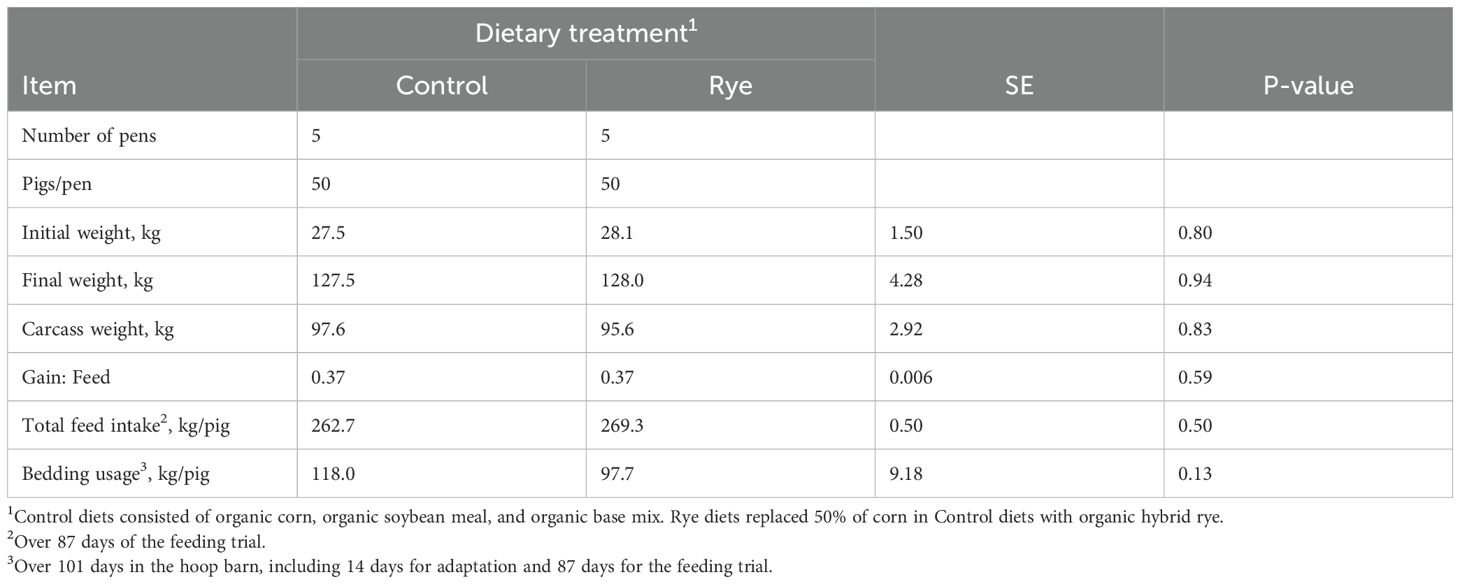
Table 1. Growth performance, carcass weight, and bedding usage of organic pigs during growing-finishing period.
3.2 Costs of feed and bedding
The total feed cost was $186/pig for the control group and $176/pig for the rye group, resulting in $10/pig potential savings on feed for rye pigs (Table 2). The cost of straw was $20/pig for the control group and $16/pig for the rye group, with $4/pig potential savings on bedding. Over the two years, pigs in the rye group saved $14/pig on feed and bedding compared to pigs in the control group.
The estimated revenue for rye pigs ($379/pig) was $8/pig less than for control pigs ($387/pig), due to slightly lighter carcass weight of rye pigs. However, the swine net return for rye pigs ($187/pig) was higher than for control pigs ($181/pig), resulting in $6/pig swine saving because of the lower costs of feed and bedding for rye pigs than for control pigs.
3.3 Base crop enterprise analysis
Rye grain yield was 6,528 kg/ha and 4,331 kg/ha (13.5% moisture) in 2022 and 2023, respectively, for a two-year average of 5,430 kg/ha. The yield of rye straw was 4,037 kg/ha and 2,233 kg/ha in 2022 and 2023, respectively, for an average of 3,135 kg/ha (Table 3). Based on the rye grain consumed and straw usage by pigs in the current study, the average rye produced per hectare over the two years can feed 58 pigs but is only enough straw to bed 32 pigs. The cash value was $1,278/ha for rye grain and $517/ha for straw, resulting in a cash crop value of $1,795/ha. The total production cost of growing rye was $1,642/ha on average over the two years. Consequently, the crop net return was estimated to be $153/ha.
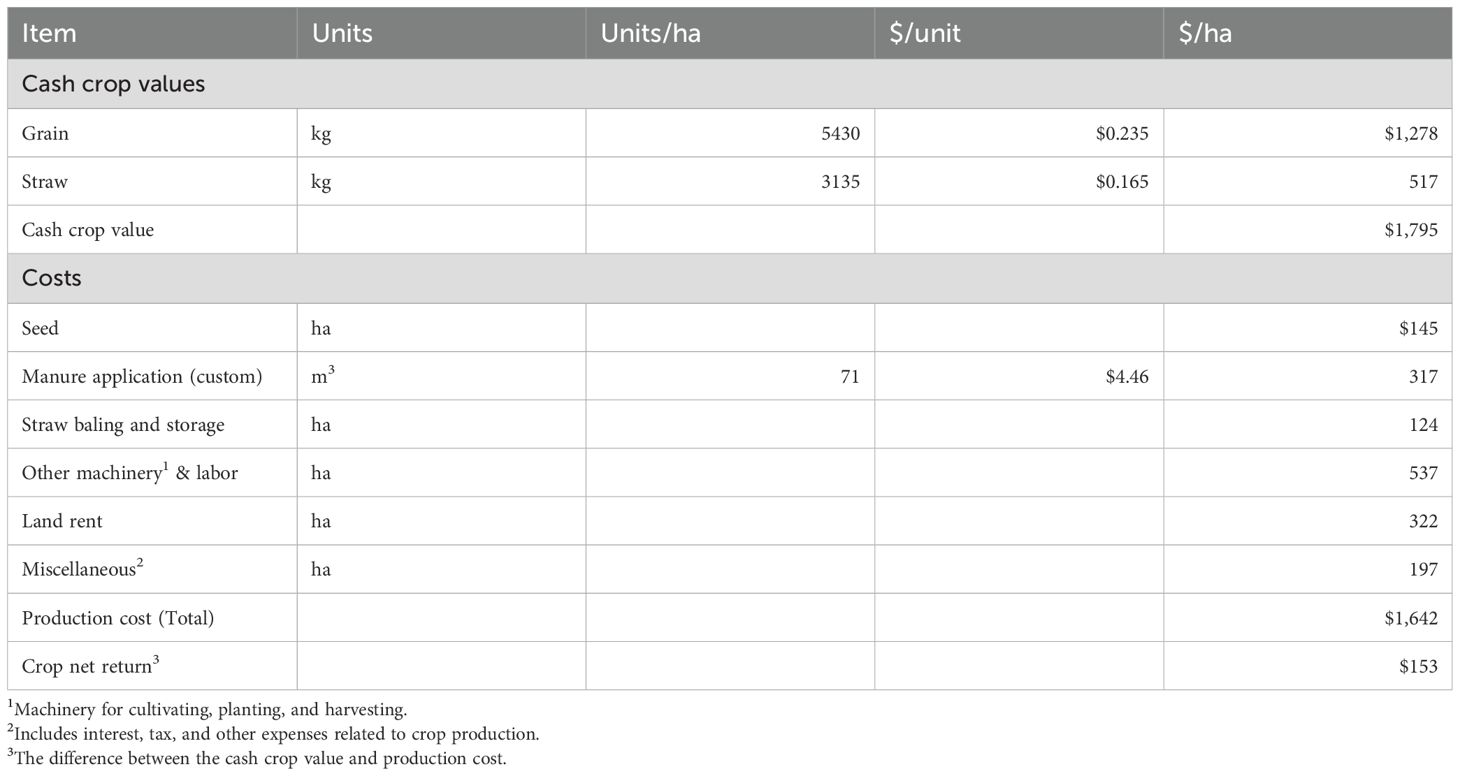
Table 3. Base enterprise budget analysis of crop net returns and costs of growing rye as a cash crop (Average of 2022 and 2023).
3.4 Sensitivity analysis
Crop net returns depend on both the yield and price of rye grain (Table 4). At the lowest yield level, crop net returns were all negative and varied from -$690/ha to -$245/ha as the price increases from the lowest to the highest level. Alternatively, when price was at the lowest level, crop net returns were all negative, except for the highest yield scenario. With the impacts of yield and price combined, crop net returns can change from -$690/ha to $919/ha.
The total production costs of growing rye increased from $1,315/ha in 2018 to $1,723/ha in 2024 (Table 5). Cost changes in machinery were the major contributor to the total production cost changes over the years, from $731/ha to $1,038/ha. The average cost ($1,642/ha) of rye production during the period of this study between 2022 and 2023 was higher than the average over the seven years ($1,493/ha).
Variations in market price and production costs of rye resulted in changes in crop net returns. Between 2018 and 2024, the combined changes in market price and production cost resulted in the cash crop value of rye grain and straw varied from the lowest $1,293/ha to the highest $1,831/ha (Table 6). The average cash crop value over the study period between 2022 and 2023 ($1,795/ha) was higher than the seven-year average ($1,575/ha). During the same period, crop net returns varied from -$138/ha to $279/ha. The average crop net return between 2022 and 2023 ($153/ha) was higher than the seven-year average ($83/ha).
Crop prices and production costs also influenced swine savings for using rye to feed and bed organic pigs. When using rye grain to replace 50% of corn in feed and using rye straw to bed organic pigs, the swine enterprise was estimated to achieve swine savings in the range of $5/pig to $11/pig over the seven years (4th column of Table 6), compared with a swine enterprise purchasing organic corn and wheat straw. The average swine saving between 2022 and 2023 was $6/pig, slightly lower than the seven-year average ($8/pig). On a per hectare basis, growing rye to feed and bed organic pigs as in the current study will result in swine savings from $309/ha to $563/ha over the seven years (5th column of Table 6), assuming each hectare of rye crop will feed and bed 58 pigs. The costs of purchasing 2,492 kg/ha of straw for 26 pigs are included in this analysis because the rye straw produced per hectare is only enough to bed 32 pigs. The average swine saving per hectare between 2022 and 2023 ($331/ha) was lower than the seven-year average ($463/ha). Crop net returns combined with swine savings ranged from $319/ha to $666/ha (the last column of Table 6), assuming the swine enterprise “purchases” the rye grain and straw from the rye crop enterprise, so the “purchase cost” to the swine offsets the “cash crop value” to the crop enterprise. The average of the crop net return combined with swine savings between 2022 and 2023 ($484/ha) was lower than the seven-year average ($546/ha).
4 Discussion
To our knowledge, this study is the first to evaluate the economic viability of growing hybrid rye to feed and bed organic pigs. An initial concern for farmers to use new crops for feed ingredients will be potential risks for reduced livestock growth performance, which could ultimately result in reduced profitability (Li et al., 2021; Sullivan, 2023). Results of the current study demonstrated that rye can successfully replace 50% of corn in pig feed without negative impacts on growth performance, including feed intake and weight gain. The average live weight at marketing was almost identical between control and rye pigs. However, the average carcass weight of rye pigs was 2 kg lighter than control pigs due to lower dressing percentage for rye pigs. The lower dressing percentage for rye pigs may be attributed to the higher fiber content in rye diet compared to control diet as discussed by Lima et al. (2025). Similar results have been reported previously. For instance, Sullivan (2023) reported that using hybrid rye to replace corn in feed for growing-finishing pigs resulted in reduction of dressing percentage, although (McGhee and Stein, 2023) did not detect any difference in dressing percentage between pigs fed corn and rye diets. In the current study, the difference in carcass weight resulted in $8/pig less revenue for rye pigs compared with control pigs. However, the swine net return was still higher for rye pigs due to the lower costs of feed and bedding than for control pigs. The estimated savings on feed were due to the lower price of rye grain than organic corn. The savings on bedding were due to less usage of rye straw by rye pigs compared to wheat straw used by control pigs. While it is unclear why pigs in the rye group used less bedding than pigs in the control group, one might speculate that absorbency of wheat and rye straw are different. Straw absorbency is not well studied, and further investigation may be needed to evaluate the differences between rye and wheat straw as bedding materials for organic pigs. Nevertheless, results of the current study indicate that replacing 50% of organic corn with rye in feed and using rye straw as bedding materials during the growing-finishing period can save $10/pig on feed and $4/pig on bedding, resulting in $6/pig swine savings compared with purchasing organic corn and wheat straw for organic pigs during the same period.
In the current study, organic hybrid rye grain yield in 2022 reached the upper limit of the anticipated range (Albert Lea Seed, 2022; Hackauf et al., 2022). However, in 2023 yield was much lower than in 2022 and close to the lowest end of the expected yield, likely due to lower rainfall in the area and associated high weed pressure on the organic field. A dry spring and summer resulted in a very short hybrid rye crop which contributed to the reduced straw yield in 2023 as well. The straw yield weighed 62% and 52% of the grain yield in 2022 and 2023, respectively. Because the yield of grain and straw in the two years represented the highest and lowest yields, the average yield over the two years in the current study may represent the means of rye grain and straw yield in commercial production.
Both yield and price of rye grain can influence dramatically crop net returns. Besides calculating crop net returns using the average yield and price set for the current study, we further evaluated sensitivity of crop net returns to yield and price of rye grain while holding production costs constant at $1,642/ha. Results indicate that a minimal yield of 5,022 kg/ha (or 80 bushels/acre) with a minimal price of $0.24/kg for rye grain is needed for the crop enterprise to be profitable. For every two cents per kg increase in price, the crop net return can roughly increase by $200/ha. When the rye grain price dropped to $0.16/kg, the highest yield of 6,905 kg/ha is needed to be profitable. In organic production, rye yield can vary from 4,331 kg/ha to 6,528 kg/ha as observed in the current study. When rye grain yield is below 4,394 kg/ha, crop net return will become negative at any price examined in this analysis, suggesting that the crop enterprise will lose money. In our analysis, organic rye should be priced at a minimum of $0.28/kg and grain yield must be greater than 5,022 kg/ha to be profitable, assuming $1,642/ha for the total production costs.
Total production costs for growing rye increased by 31% from 2018 to 2024, resulting in an average of 4.4% increase each year. On average, machinery costs accounted for 58% of the total production costs. The increase in machinery costs was 42% over the seven years (6% increase each year) and it was the major contributor to the increase in total production costs. The machinery costs included manure application expenses. The custom manure operator rates during the seven years were used in this analysis. The manure nutrients are not valued in the budget other than for the application costs because many pig farmers do not charge crop farmers for the manure as a way to insure manure removal. In contrast to machinery costs, the costs for land rental only increased by 8% over the seven years.
Farmers usually cannot control market prices and production costs of their crops. When integrating rye into organic swine production, farmers need to know how crop net returns would fluctuate with variations in the price and production cost of organic rye. Market prices of rye grain and straw influence the cash crop value, and consequently crop net returns. Between 2018 and 2024, the lowest cash crop value of rye grain and straw was $1,293/ha in 2020 during the COVID pandemic, and the highest cash crop value was $1,831/ha in 2022 after the pandemic. Clearly, the pandemic impacted the global economy, and consequently influenced market prices of crops, including rye. However, the lowest cash crop value of rye in 2020 did not result in the lowest crop net return for growing rye as a cash crop. The lowest crop net return was observed in 2024, due to the increased production costs. With the impacts of market prices and production costs combined, the highest crop net return was observed in 2021. The average crop net return over the seven years was estimated to be $83/ha, which is much lower than the expected crop net return for organic corn ($1,048/ha). However, when integrating rye production into organic swine production by using rye grain to feed and straw to bed pigs, the swine enterprise can achieve $5 to $11/pig (averaged $8/pig) swine savings compared to purchasing organic corn and wheat straw. Because organic rye grain and straw produced on each hectare of land can feed 58 organic pigs and bed 32 organic pigs, respectively, growing rye for organic pigs will result in average of $463/ha swine savings for the swine enterprise, compared to a swine enterprise raising control pigs in the current study. In this analysis, the costs of purchasing an additional 2,492 kg of straw to bed the 26 pigs in the treatment group were included because the straw produced per hectare in the current study can only bed 32 pigs, not 58 pigs as the grain can feed. These results indicate that swine savings for using rye as feed and bedding are in the range of $309 to $634/ha, which are more stable and higher compared to the crop net returns for growing rye as a cash crop. When a farmer operates a combined crop and swine enterprise, the loss in crop net returns for growing rye as a cash crop can be offset by the swine savings from raising organic pigs using rye grain and straw. Consequently, the estimated crop net returns combined with swine savings were in the range from $319 to $666/ha, with an average of $546/ha over the seven years.
5 Conclusion
The current study demonstrates that integrating rye into organic swine production is economically viable under the circumstances described in this study. Including rye grain to replace 50% of corn in feed and using rye straw to replace wheat straw for growing-finishing pigs did not negatively affect growth performance of pigs and saved $14/pig on feed and bedding. Crop yield, price and production costs all impacted economic viability. For farmers to be profitable by growing rye as a cash crop, the minimal yield and price for rye grain need to be around 5000 kg/ha and $0.24/kg, respectively, with production costs of $1,642/ha. The continuous increase in production costs, coupled with changes in market prices of the crop, can result in crop net returns for growing rye varying from positive to negative. Growing rye to feed and bed organic pigs can offset the crop net returns, resulting in crop net returns combined with swine savings in the range of $319 to $666/ha for a combined crop and swine enterprise. These results suggest that integrating rye into organic swine production can benefit both crop and pig farmers.
Data availability statement
The original contributions presented in the study are included in the article/supplementary material. Further inquiries can be directed to the corresponding author.
Ethics statement
The animal study was approved by University of Minnesota Institutional Animal Care and Use Committee. The study was conducted in accordance with the local legislation and institutional requirements.
Author contributions
YL: Conceptualization, Data curation, Formal Analysis, Project administration, Supervision, Writing – original draft, Writing – review & editing. MK: Data curation, Formal Analysis, Investigation, Writing – original draft, Writing – review & editing. WL: Formal Analysis, Writing – original draft, Writing – review & editing. GL: Data curation, Writing – review & editing. AH: Data curation, Writing – review & editing. MW: Writing – review & editing. AG: Writing – review & editing. JT: Writing – review & editing. LJ: Supervision, Writing – review & editing.
Funding
The author(s) declare that financial support was received for the research, and/or publication of this article. This work was supported by the Organic Research and Extension Initiative Program (Award# 2021-53100-34894) from the USDA National Institute of Food and Agriculture.
Conflict of interest
The authors declare that the research was conducted in the absence of any commercial or financial relationships that could be construed as a potential conflict of interest.
Generative AI statement
The author(s) declare that no Generative AI was used in the creation of this manuscript.
Publisher’s note
All claims expressed in this article are solely those of the authors and do not necessarily represent those of their affiliated organizations, or those of the publisher, the editors and the reviewers. Any product that may be evaluated in this article, or claim that may be made by its manufacturer, is not guaranteed or endorsed by the publisher.
References
Albert Lea Seed (2022). KWS hybrid rye production guide. Available online at: http://alseed.com/wp-content/uploads/2022/08/KWS-Hybrid-Rye-Production-Guide.pdf (Accessed July 2, 2024).
Basche A. D., Kaspar T. C., Archontoulis S. V., Jaynes D. B., Sauer T. J., Parkin T. B., et al. (2016). Soil water improvements with the long-term use of a winter rye cover crop. Agr. Water Manage. 172, 40–50. doi: 10.1016/j.agwat.2016.04.006
Belasco E. and Schahczenski J. (2021). Is organic farming risky? An evaluation of WFRP in organic and conventional production systems. Agric. Resour. Econ. Rev. 50, 63–75. doi: 10.1017/age.2020.13
Boggess M., Stein H., and DeRouchey. J. (2018). Alternative feed ingredients for swine rations (Urbana-Champaign, Illinois, USA: University of Illinois). Available online at: https://nutrition.ansci.illinois.edu/sites/default/files/AlternativeFeedIngredientsSwineDiets.pdf.
Bower A. (2020). Hogs show similar gains when hybrid rye replaces 50% of corn (Des Moines, Iowa, USA: Practical Farmers of Iowa). Available online at: https://practicalfarmers.org/2020/04/hogs-show-similar-gains-when-hybrid-rye-replaced-50-of-corn/.
CFFM (University of Minnesota Center for Farm Financial Management) (2024). FINBIN farm financial database. Available online at: https://finbin.umn.edu/ (Accessed January 15, 2025).
Christy C. (2018). Small grains, large grains: feeding rye to pigs (Des Moines, Iowa, USA: Practical Farmers of Iowa). Available online at: https://practicalfarmers.org/2018/10/small-grains-large-gains-feeding-rye-to-pigs/.
Gamage A., Gangahagedara R., Gamage J., Jayasinghe N., Kodikara N., Suraweera P., et al. (2023). Role of organic farming for achieving sustainability in agriculture. Farm. Syst. 1, 100005. doi: 10.1016/j.farsys.2023.100005
Greene C. (2018). Organic corn prices are generally two to three times higher than conventional corn prices (Washington D. C., USA: USDA Economic Research Service). Available online at: https://www.ers.usda.gov/data-products/chart-gallery/gallery/chart-detail/?chartId=89171:~=Organic%20corn%20prices%20are%20generallyevery%20phase%20of%20crop%20production.
Gross S., Waldrop M. E., and Roosen J. (2021). How does animal welfare taste? Combining sensory and choice experiments to evaluate willingness to pay for animal welfare pork. Food Qual. Prefer. 87, 104055. doi: 10.1016/j.foodqual.2020.104055
Hackauf B., Siekmann D., and Fromme F. J. (2022). Improving yield and yield stability in winter rye by hybrid breeding. Plants 11, 2666. doi: 10.3390/plants11192666
Herbstritt S., Richard T. L., Lence S. H., Wu H. Q., O’Brien P. L., Emmett B. D., et al. (2022). Rye as an energy cover crop: Management, forage quality, and revenue opportunities for feed and bioenergy. Agric 12, 1691. doi: 10.3390/agriculture12101691
Lammers P. J., Stender D. R., and Honeyman M. S. (2007). Niche pork production (Ames: Iowa Pork Industry Center, Iowa State University). Available online at: https://www.ipic.iastate.edu/publications/ipicnpp.pdf.
Lazarus W. F. (2024). Farm machinery management – machinery cost estimate (St Paul, Minnesota, USA: Department of Applied Economics, University of Minnesota). Available online at: https://wlazarus.cfans.umn.edu/william-f-lazarus-farm-machinery-management.
Li Y. Z., Lazarus W. F., Reese C., Hilbrands A. M., Cox R. B., Forcella F., et al. (2021). Integrating Camelina into organic pig production—impact on growth performance of pigs, costs, and returns. Front. Sustain. Food Syst. 5. doi: 10.3389/fsufs.2021.759721
Lima G., Kavanagh M., Hilbrands A., Johnston L. J., and Li Y. (2025). Dietary winter hybrid rye minimally influences performance and carcass characteristics of organically-raised growing-finishing pigs. Front. Sustain. Food Syst. 9, 1576412. doi: 10.3389/fsufs.2025.1576412
McGhee M. L. (2019). The nutritional value of hybrid rye fed to growing pigs (Urbana-Champaign, Illinois, USA: University of Illinois). Available online at: https://nutrition.ansci.illinois.edu/sites/default/files/MCGHEE-THESIS-2019.pdf. Thesis for the Master Degree in Animal Science.
McGhee M. L., Harsh B. N., and Stein H. H. (2021). High inclusion rates of hybrid rye instead of corn in diets for growing-finishing pigs do not influence the overall growth performance and most carcass traits are not influenced by hybrid rye. J. Anim. Sci. 99, 1–8. doi: 10.1093/jas/skab324
McGhee M. L. and Stein H. H. (2023). Preference for feed, but not growth performance, is reduced if hybrid rye replaces corn in diets for growing pig. Anim. Feed Sci. Technol. 296, 115566. doi: 10.1016/j.anifeedsci.2022.115566
National Agricultural Statistics Service. USDA. (2024). Quick Stats. Available online at: https://quickstats.nass.usda.gov (Accessed January 15, 2025).
NOP (National Organic Program) (2013). Organic livestock requirements (Washington D. C., USA: Agricultural Marketing Service, USDA). Available online at: https://www.ams.usda.gov/sites/default/files/media/Organic%20Livestock%20Requirements.pdf.
NRC (National Research Council) (2012). Nutrient requirements of swine. 11th Rev. Ed (Washington, DC: Natl. Acad. Press).
Plastina A., Johanns A., and Magwaba K. (2024). 2024 iowa farm custom rate survey. Ag decision maker (Des Moines, Iowa, USA: Iowa State University Extension and Outreach). Available online at: https://www.extension.iastate.edu/wayne/2024-farm-custom-rate-survey. File A3-10.
Pork Checkoff (2021). Cost of pork production - Know your bottom line. Available online at: https://porkcheckoff.org/news/cost-of-pork-production/ (Accessed July 2, 2024).
Pugliese M., Previti A., De Pascale A., Alibrandi A., Zirilli A., Biondi V., et al. (2023). Exploring consumer behavior and preferences in welfare-friendly pork breeding: A multivariate analysis. Foods 12, 3014. doi: 10.3390/foods12163014
Schahczenski J. and Post E. (2019). Understanding organic pricing and costs of production (Butte, Montana, USA: National Center for Appropriate Technology (NACT). Available online at: https://attra.ncat.org/publication/understanding-organic-pricing-and-costs-of-production/.
Sullivan Z. (2005). Feeding small grains to swine (Des Moines, Iowa, USA: Iowa State University). Available online at: https://store.extension.iastate.edu/product/12122.
Sullivan C. (2023). The impact of increasing dietary levels of hybrid rye on growing-finishing pig performance, carcass characteristics, and meat quality. Available online at: https://openprairie.sdstate.edu/cgi/viewcontent.cgi?article=1697&context=etd2 (Accessed January 23, 2025). Electronic Theses and Dissertations.
USDA (2020). “National organic program,” in Code of federal regulations, title 7 part 205 (Office of the Federal Register, National Archives and Records Administration, Washington, DC). Available at: https://www.ecfr.gov/current/title-7/subtitle-B/chapter-I/subchapter-M/part-205.
USDA Agricultural Marketing Service (2024). Midwest regional organic grain and feedstuffs report. Available online at: https://www.ams.usda.gov/mnreports/lsbmworganicgf.pdf (Accessed January 14, 2025).
USDA National Agricultural Statistics Service (2024). Quick stats tool. Available online at: http://www.nass.usda.gov/Quick_Stats/ (Accessed January 14, 2025).
Keywords: costs and returns, organic agriculture, pigs, rye, sensitivity analysis
Citation: Li YZ, Kavanagh M, Lazarus WF, Lima G, Hilbrands AM, Wilson M, Garcia y Garcia A, Tallaksen J and Johnston LJ (2025) Evaluating the economic viability of growing winter hybrid rye to feed and bed organic pigs. Front. Anim. Sci. 6:1566483. doi: 10.3389/fanim.2025.1566483
Received: 02 April 2025; Accepted: 10 June 2025;
Published: 16 July 2025.
Edited by:
Suresh Neethirajan, Dalhousie University, CanadaReviewed by:
Hans Stein, University of Illinois at Urbana-Champaign, United StatesCaifang Wen, Wageningen University and Research, Netherlands
Copyright © 2025 Li, Kavanagh, Lazarus, Lima, Hilbrands, Wilson, Garcia y Garcia, Tallaksen and Johnston. This is an open-access article distributed under the terms of the Creative Commons Attribution License (CC BY). The use, distribution or reproduction in other forums is permitted, provided the original author(s) and the copyright owner(s) are credited and that the original publication in this journal is cited, in accordance with accepted academic practice. No use, distribution or reproduction is permitted which does not comply with these terms.
*Correspondence: Yuzhi Z. Li, eXV6aGlsaUB1bW4uZWR1
†These authors share first authorship
 Yuzhi Z. Li
Yuzhi Z. Li Megan Kavanagh
Megan Kavanagh William F. Lazarus3†
William F. Lazarus3† Gabriella Lima
Gabriella Lima Axel Garcia y Garcia
Axel Garcia y Garcia Joel Tallaksen
Joel Tallaksen Lee J. Johnston
Lee J. Johnston